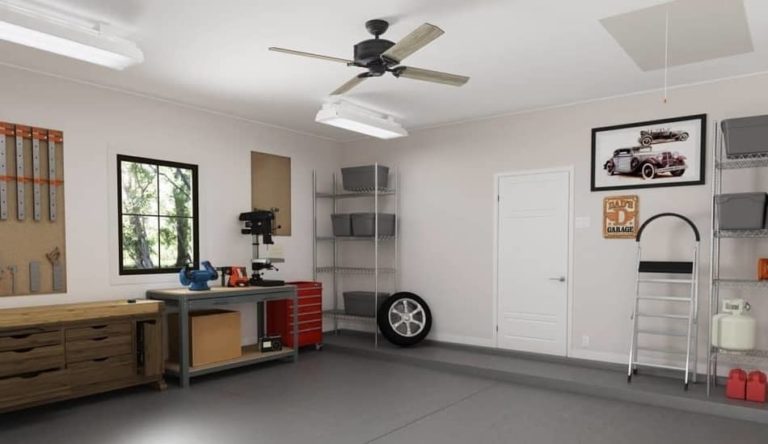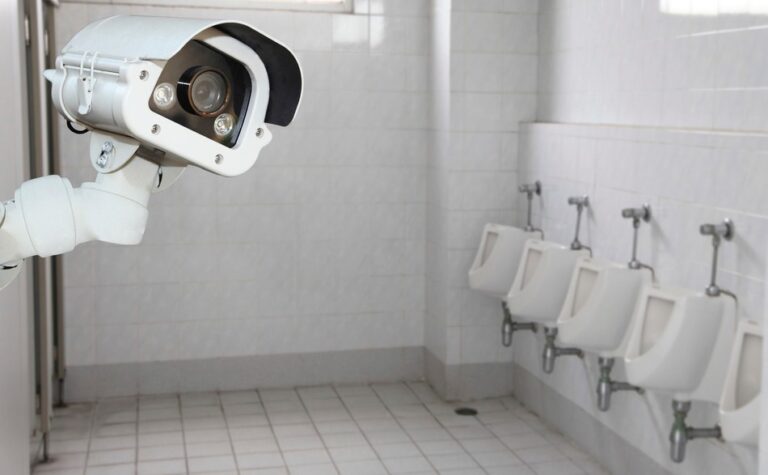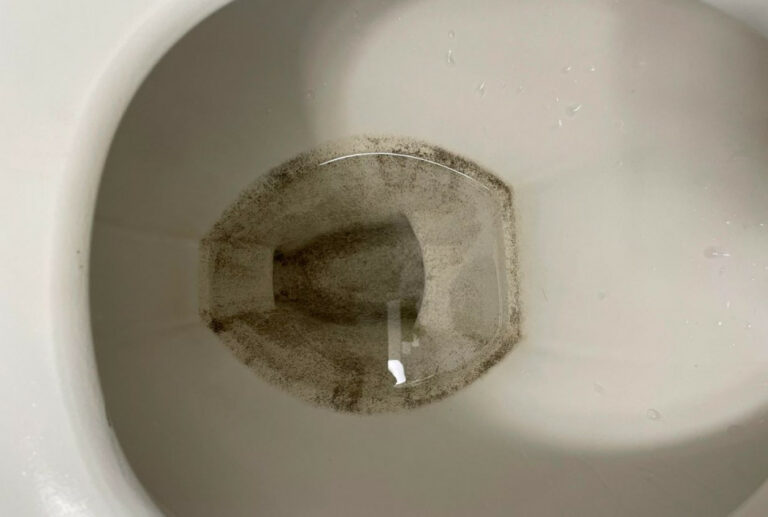How to Properly Ventilate a Bathroom Without A Window?
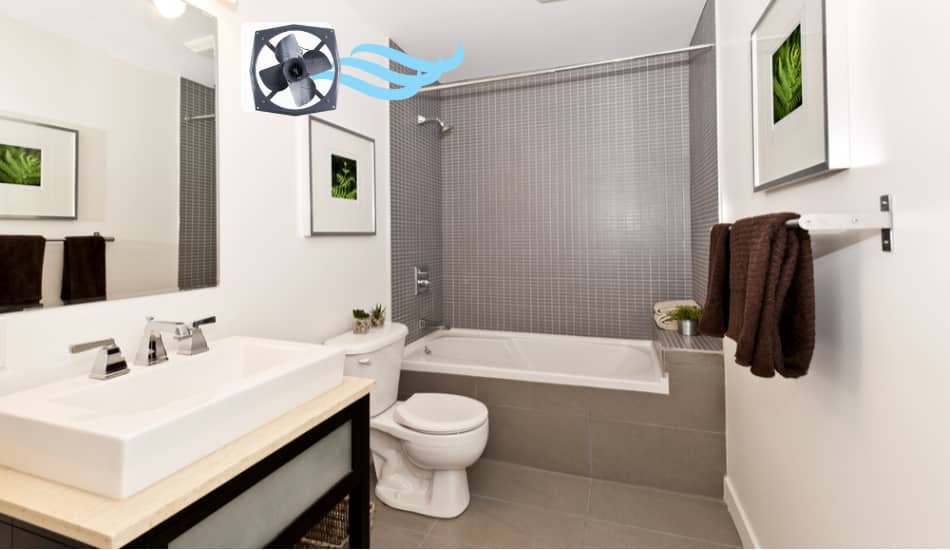
Bathrooms without windows are difficult to maintain. Not only do such bathrooms emit nasty and musty odors, but they also pose a number of health risks. As a result, it’s crucial to ventilate such rooms to remove excess moisture from the air and keep the bathroom dry and fresh.
Fortunately, ventilating a bathroom without a window is possible and only takes a little time (and money) to keep it dry and safe. In this article, we’ll talk about how you can ventilate a bathroom that has no windows. So, let’s start!
Table of Contents
How to Vent a Bathroom Without A Window?
So How to Ventilate a Bathroom Without A Window? The proper way to vent a bathroom without a window is by installing an exhaust fan. Other methods are by using an air purifier, dehumidifier, portable fan, or moisture absorber. Ways that don’t require any prior investment are leaving the door open and wiping down your walls after a shower.
For those who want to learn more, you can also read this related article; How To Kill Mold With Temperature (Heat & Cold Treatment).
The Importance Of Bathroom Ventilation
Showering, taking a bath, or just going to the toilet, contributes a lot of moisture to the bathroom air. If this moisture is trapped with nowhere to go, it begins to affect and eat away the materials in your bathroom, because mold flourishes in humid environments.
Mold spores are almost always present, but when they settle in a damp environment like a bathroom, they reproduce rapidly in cabinets, walls, tiles, and many other places in the bathroom. Mold can even deform plywood cabinets and closets. Once it starts to multiply, it devours almost anything in its path in no time.
Besides, it spreads fastly and can even ruin the furniture, mold is also nasty to see. Its ugliness makes it even worse because the bathroom is supposed to be a clean and sanitary place. Mold is also not good for your health. Based on research done by the Centers for Disease Control and Prevention (CDC) research, mold can cause fungal infections, allergies, respiratory difficulties, and asthma. Furthermore, a damp, musty smell stays behind in an unventilated bathroom with excessive humidity.
Related Article: Where To Hang Wet Towels In A Small Bathroom
Ways to Improve Ventilation In a Bathroom Without a Window
Fortunately, various bathroom ventilation options can be implemented easily and quickly to help you ventilate a bathroom that lacks windows. Here are eight convenient and great techniques that you can use to ventilate a bathroom without a window:
1. Use an Exhaust Fan
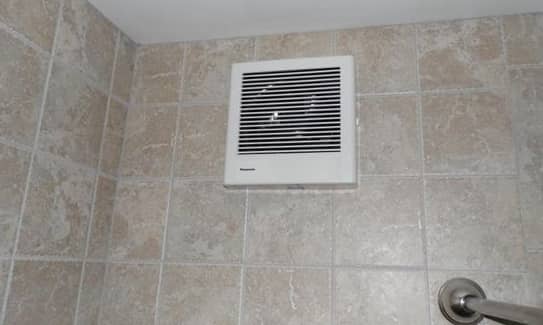
Sometimes bathrooms with no windows need to have an exhaust fan by building codes and regulations. If this is the case for you; feel free to skip this step. If not, you should seriously think about installing one. There’s nothing like the mechanical motion of an exhaust fan that sucks the air out of a bathroom and expels all the moisture and unpleasant odor to the outside.
An exhaust fan works the best when it is turned on during a shower or when you’re taking a bath. It would be best to let it work for 15-20 minutes after you are finished with a bath or shower. Make sure the exhaust fan you select is large enough for your bathroom. For example, if your bathroom is 100 square feet, you’ll need a fan with a 100 CFM rating. Anything less isn’t going to help.
2. Wipe Down Your Walls After Shower
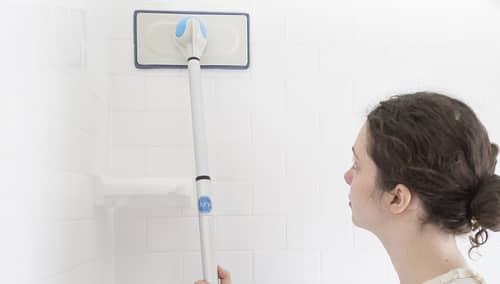
If you are not able to install an exhaust fan in your bathroom, you should try some other method to get rid of moisture. It is always better to be safe than sorry. So, before the dampness causes your bathroom to deteriorate, you should take action and manually remove moisture. This can easily be accomplished by hand-wiping any spills or drips from your bathroom once you’ve finished using it.
Spills include water on the floor, steam dripping down the walls, fogging in the mirror, and so forth. It’s best to wipe the tiles, cabinets, walls, and mirrors with an absorbent towel, a sponge, or a microfiber cloth to avoid leftover moisture after wiping. For wiping the floor, it’s fastest to use a mop. This may be a time-consuming and tiresome job, but it will ensure that your bathroom is dry and mold-free.
3. Open All the Doors
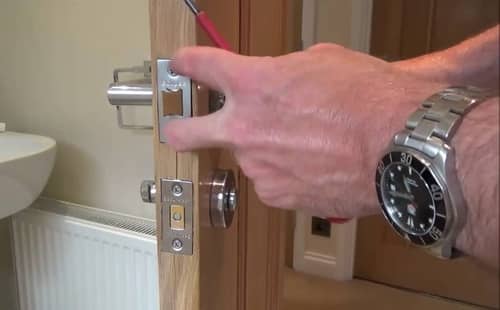
An easy and quick way to ventilate a moisture-filled bathroom is by leaving the door open after taking a bath or shower. It would be even better if you have an open door all the time during the shower. This will allow steam to escape right away, preventing it from gathering up and trapping inside. Additionally, that way fresh air can keep entering.
The same rule applies if you have a shower curtain. If you close your shower with a curtain, pay attention to not pull it all the way back because the curtain folds are perfect for water droplets to catch on. Therefore, leave it open just a little bit, around one-fourth, to let moisture out.
4. Place Portable Fans

You can also use a portable fan to swiftly dry wet surfaces in the bathroom as an extra step. The fan should be placed in a way, so it points to the wettest areas. Consider purchasing an oscillating fan that can be adjusted to various angles and aim in various directions. Secondly, try to find the right model that’s is light and compact. The compatibility is important so that the fan can easily fit it into tiny spots in the bathroom.
5. Use a Dehumidifier
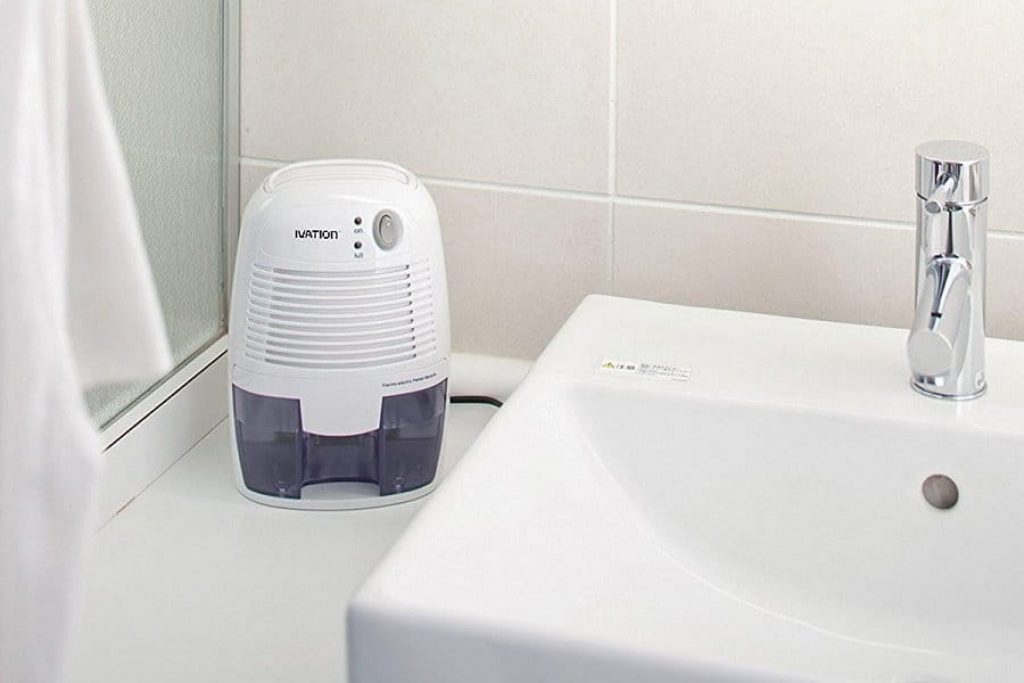
A dehumidifier is a great way to remove moisture from any environment. These ingenious small devices can absorb moisture from the air and retain it in their tanks via condensation. Furthermore, thanks to technological improvement, you can now get them for reasonable prices. Check the price here on Amazon.
Also, one thing that you should pay attention to is that the dehumidifier isn’t placed on a moist floor. Small and compact dehumidifier units can fit on shelves which is a great spot to have them. Casters and plastic feet can also be installed on the humidifier.
How Often Should I Empty My Dehumidifier?
It is important to empty the dehumidifier from time to time to make sure there is enough storage space in the bucket for the new liquid to be taken in. Humidity levels in your room determine the actual frequency of how many times it is necessary to make a discharge. An estimate is to empty your dehumidifier bucket at least once a day.
You should unload your dehumidifier more regularly if you live in humid conditions. If you aren’t too sure when to empty it, just keep an eye on your dehumidifier’s water level.
6. Don’t Dry Towels Inside
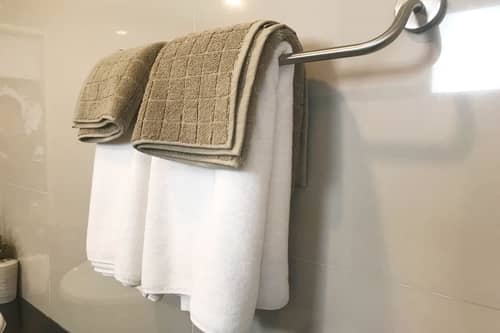
Most people hang their towels in their bathrooms. This is something that people have been doing for generations, and it seems logical. This is obviously okay if your bathroom has windows, but if it does not, we suggest hanging them elsewhere. Towels release moisture into the air, leaving a musty, unpleasant odor behind.
7. Use a Moisture Absorber
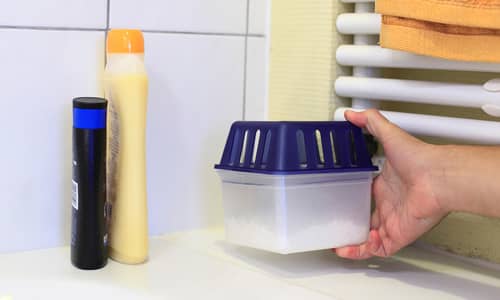
If none of the previously mentioned methods work for you, consider getting a moisture absorber such as Damprid. Damprids are affordable and useful little bags that absorb excess moisture from the air. They are made from calcium chloride crystals. They are super simple to use because you can just hang them in the bathroom, and they will effectively absorb moisture and even odors, leaving the area smelling clean and fresh.
Depending on how often your bathroom has excess moisture, their functioning time varies. Usually, one pack of Damprid lasts around 45 to 60 days. Nevertheless, because they’re inexpensive (they cost around $5 per container), you’ll get an effective solution for eliminating dampness and aroma in restrooms.
8. Use an Air Purifier
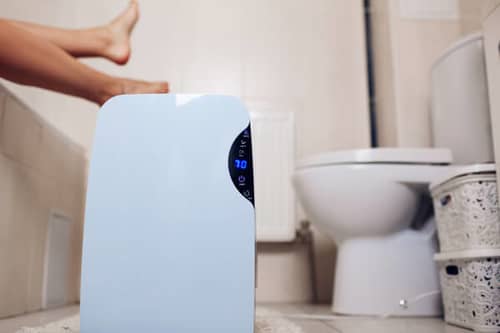
Air purifiers are beneficial in every room, but particularly in the bathroom. They are used to help with air circulation, reducing moisture buildup, and eliminating odors and mold particles that may already be present in your bathroom. A great model is the VEVA 8000 Air Purifier. It features three speeds and has a retractable base that allows it to stand independently and be placed on a desk or nightstand.
This video gives you great ideas and visuals on how to ventilate a windowless bathroom. If you want to find out more than what has already been mentioned here, go ahead and watch it:
The Problems You Face Without Having A Window
Many issues come with having a bathroom with no windows, especially if you enjoy being in a breezy setting with plenty of oxygen. When you take a shower, the moisture rises, which creates total discomfort. Especially if you enjoy a hot bath, the air within your bathroom will become extremely suffocating. There could be water all over the place, including the wall. This can easily cause issues such as fungus and harm to bathroom components.
Add Plants to Your Bathroom to Reduce Moisture
Plants not only look nice, but they also absorb moisture, lowering the overall humidity in the room. As a result, your space will be more enjoyable to be in and will also look great. Just make sure your houseplants aren’t too far away from your lavatory venting fan to help fresh, natural aromas circulate as much as possible.
What You Need to Know About Bathroom Ventilation
No matter how big or small your bathroom is, you for sure need some sort of ventilation system. It’s a common misconception that larger bathrooms don’t require a ventilation system. That isn’t true because even in big bathrooms, the gas evaporates into the air.
A ventilation system should be sized appropriately. HVAC experts are qualified to give advice and install ventilation systems with the appropriate CFM (Cubic feet per minute) for each room while making sure the air is evacuated at the proper rate. HVAC stands for heating, ventilation, and air conditioning.
There is a number of ventilation fans to pick from, some having only the fundamental features of venting air out, while others have additional features like a nightlight. The night-light feature is ideal for tiny bathrooms that require multifunctional solutions in order to fit everything inside.
There are also fans with integrated heating and lighting systems meant for bigger bathrooms. They are perfect for keeping you warm after a shower while also providing additional lighting for your bathroom requirements.
Feel free to read also, Do Towel Rails Heat the Bathroom.
FAQ: People Also Ask
1. What happens when there is no ventilation?
Having insufficient or no ventilation is dangerous because oxygen levels drop, and carbon dioxide builds up. If it gets too extreme conditions, this can cause shortness of breath, headaches, and weariness.
2. Is it OK to have a bathroom without a window?
It’s okay not to have a window in the bathroom if you do have an adequate ventilation system. A bathroom without windows can for sure be challenging, as it’s the area that needs the most airflow.
3. How do you get rid of bathroom smell without windows?
To get rid of piled-up nasty odor from the bathroom, try using baking soda, lemon juice, and vinegar to clean it. These products are known for being successful in decreasing odor. That’s why using those as cleaning detergents should remove the bad smell, especially around the toilet area that requires more frequent cleaning.
Final Thoughts
Using only one strategy to ventilate a windowless bathroom is unlikely to be completely beneficial, especially if you take a hot shower every day, but using a few combined should do the job. If you are a fan of baths, try to get an exhaust fan. That approach will work great. Even if you don’t take long baths or showers often, make sure your bathroom is ventilated in some way for a comfortable and safe breathing zone. I hope that this article helped you.




